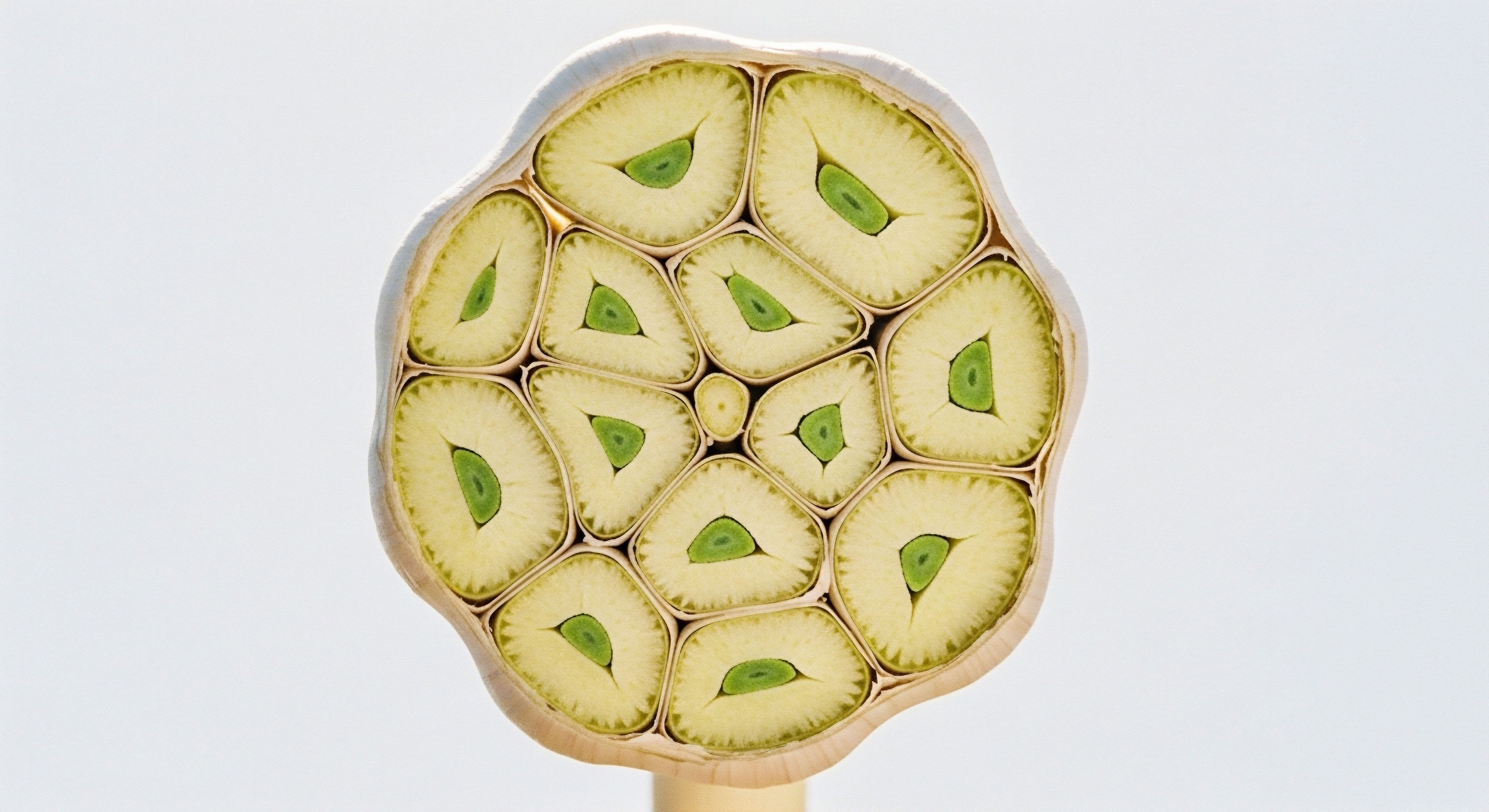

Fundamentals
The decision to begin a journey of hormonal optimization is deeply personal, often born from a feeling that your body’s vitality has diminished. You may be experiencing a decline in energy, a shift in mood, or a general sense that your internal systems are misaligned.
When considering testosterone therapy, the question of fertility introduces a profound layer to this decision. Understanding how to safeguard this fundamental aspect of your biology is the first step toward a protocol that supports your complete well-being.
Your body operates on an elegant and continuous stream of communication. At the heart of male hormonal health and fertility is a system known as the Hypothalamic-Pituitary-Gonadal (HPG) axis. Think of it as a sophisticated internal command structure. The hypothalamus, located in your brain, acts as the mission commander. It sends a specific signal, Gonadotropin-Releasing Hormone (GnRH), to the pituitary gland.
The pituitary, acting as the field general, receives this signal and, in response, dispatches two critical hormonal messengers throughout the body ∞ Luteinizing Hormone (LH) and Follicle-Stimulating Hormone (FSH). These hormones travel through the bloodstream directly to the testes, which function as specialized production centers.
LH instructs the Leydig cells within the testes to produce testosterone, the very hormone that governs so much of your masculine vitality. Simultaneously, FSH signals the Sertoli cells to initiate and maintain the production of sperm, a process called spermatogenesis.
The body’s natural production of testosterone and sperm relies on a precise communication pathway originating in the brain.
When you introduce testosterone from an external source through therapeutic protocols, the brain’s delicate sensory equipment detects that testosterone levels are adequate or high. In response, the hypothalamus logically concludes that its own production signals are no longer needed. It reduces or halts the release of GnRH.
This cessation of the initial command leads the pituitary to stop sending LH and FSH. Without these hormonal messengers, the testes are left without instructions. They subsequently decrease or stop their own production of both testosterone and sperm. This systemic shutdown is the biological reason that testosterone therapy can compromise fertility.
Preserving fertility while undergoing hormonal optimization, therefore, is about intelligently supporting this internal communication system. The goal is to provide the body with the testosterone it needs for well-being while simultaneously ensuring the testes continue to receive the signals required to maintain their vital functions. This is achieved by using specific medications that work in harmony with your biology, keeping the lines of communication open and the production centers active.


Intermediate
For the individual already familiar with the basics of the HPG axis, the next step is to understand the clinical tools used to maintain its function during testosterone therapy. These are not just ancillary additions; they are integral components of a comprehensive and forward-thinking protocol.
The primary strategy involves either directly stimulating the testes or ensuring the brain continues to send its own natural signals. This allows for the benefits of optimized testosterone levels without sacrificing the complex process of spermatogenesis.

Direct Testicular Stimulation Protocols
The most direct method for maintaining testicular function involves using a compound that acts as a substitute for the body’s natural Luteinizing Hormone (LH). This approach bypasses the upper part of the HPG axis and delivers the command to produce testosterone and maintain sperm production straight to the source.

Human Chorionic Gonadotropin (hCG)
Human Chorionic Gonadotropin is a hormone that shares a remarkable structural similarity to LH. Because of this, it can bind to and activate the LH receptors on the Leydig cells within the testes. When administered alongside testosterone therapy, hCG provides the stimulatory signal that the pituitary would normally send.
This direct activation accomplishes two critical goals ∞ it sustains intratesticular testosterone levels, which are essential for sperm production, and it prevents the testicular atrophy, or shrinkage, that can occur when the testes are inactive. HCG is typically administered via subcutaneous injection two to three times per week, with dosages adjusted based on individual response and lab markers.

Upstream HPG Axis Stimulation
An alternative strategy focuses on encouraging the body’s own command centers, the hypothalamus and pituitary, to continue their work. This is accomplished by modulating the feedback signals that the brain receives, effectively prompting it to keep sending LH and FSH to the testes.

Selective Estrogen Receptor Modulators (SERMs)
SERMs, such as Clomiphene Citrate and Enclomiphene, work at the level of the hypothalamus. Estrogen, which is converted from testosterone, provides a powerful negative feedback signal to the brain. SERMs function by blocking the estrogen receptors in the hypothalamus. The brain then perceives lower estrogen levels, which prompts it to increase the production of GnRH.
This, in turn, stimulates the pituitary to release more LH and FSH, driving natural testosterone and sperm production. For some men with secondary hypogonadism, SERMs may be used as a standalone therapy to raise testosterone levels while preserving fertility. In other protocols, they might be used after ceasing testosterone therapy to help restart the HPG axis.
Medications can preserve fertility by either directly stimulating the testes or by prompting the brain to maintain its natural signaling pathways.
The following table outlines the primary medications used to preserve fertility during or alongside testosterone therapy, comparing their mechanisms and typical roles in a clinical protocol.
| Medication | Mechanism of Action | Primary Role in Fertility Preservation | Typical Administration |
|---|---|---|---|
| Human Chorionic Gonadotropin (hCG) | Mimics Luteinizing Hormone (LH), directly stimulating Leydig cells in the testes. | Maintains testicular size and function during TRT by providing a direct stimulatory signal. | Subcutaneous Injection |
| Clomiphene Citrate (Clomid) | Blocks estrogen receptors in the hypothalamus, increasing GnRH release and subsequent LH/FSH production. | Used as an alternative to TRT or to restart the HPG axis post-cycle by stimulating the body’s endogenous production. | Oral Tablet |
| Enclomiphene | A more targeted isomer of clomiphene that specifically blocks estrogen receptors to boost LH and FSH with potentially fewer side effects. | A refined alternative to clomiphene for stimulating the natural production of testosterone and sperm. | Oral Tablet |
| Gonadorelin | A synthetic form of Gonadotropin-Releasing Hormone (GnRH) that stimulates the pituitary. | Supports the pituitary’s output of LH and FSH, helping to maintain the natural signaling cascade. | Subcutaneous Injection |

What Are the Practical Steps Involved?
Navigating these options requires a structured approach in partnership with a knowledgeable clinician. The process generally involves several key steps:
- Baseline Assessment ∞ This includes comprehensive lab work to measure baseline levels of total and free testosterone, estradiol, LH, FSH, and a semen analysis to establish a clear picture of your current fertility status.
- Goal Clarification ∞ A thorough discussion of your personal and family-building goals is essential. Are you planning for a child in the near future, or do you wish to keep your options open for a more distant timeline?
- Protocol Design ∞ Based on your labs and goals, a personalized protocol is designed. This may involve co-administering hCG with testosterone from the start or choosing a SERM-based therapy as an alternative to traditional TRT.
- Ongoing Monitoring ∞ Regular follow-up labs are conducted to ensure the protocol is effective, monitoring hormone levels and, if necessary, semen parameters to confirm that fertility is being successfully maintained.


Academic
A sophisticated understanding of fertility preservation during androgen optimization requires a detailed examination of the endocrine dynamics at play, specifically the critical difference between maintaining spermatogenesis via exogenous gonadotropin stimulation versus endogenous pulsatile hormone release. The choice of therapeutic agent fundamentally alters the state of the Hypothalamic-Pituitary-Gonadal (HPG) axis.
While both pathways may result in the presence of sperm, the underlying physiological conditions they create are distinct. The central biochemical requirement for spermatogenesis is a high concentration of intratesticular testosterone (ITT), which is orders of magnitude greater than serum testosterone levels.

Pharmacodynamics of Gonadotropin Mimetics
The administration of Human Chorionic Gonadotropin (hCG) is a direct intervention at the testicular level. By acting as an LH analogue, hCG effectively circumvents the suppressed hypothalamic and pituitary centers to stimulate Leydig cell steroidogenesis. This maintains the high ITT concentrations necessary for the maturation of spermatozoa.
Research confirms that co-administration of low-dose hCG with exogenous testosterone can successfully maintain semen parameters in many hypogonadal men. This approach, however, maintains the quiescence of the upper HPG axis. The hypothalamus and pituitary remain suppressed due to the negative feedback from both the exogenous testosterone and its aromatized metabolite, estradiol. The system is functional at the endpoint but inactive at its origin.

Restoring Endogenous Gonadotropin Pulsatility with SERMs
Selective Estrogen Receptor Modulators (SERMs), such as clomiphene and its more targeted isomer enclomiphene, operate on a different principle. They are competitive antagonists of the estrogen receptor alpha (ERα) at the level of the hypothalamus. By preventing estradiol from exerting its negative feedback, SERMs lead to an increase in the frequency and amplitude of GnRH pulses from the hypothalamus.
This restores the natural, pulsatile secretion of LH and FSH from the gonadotrophs in the pituitary gland. This cascade results in endogenous Leydig cell stimulation to produce testosterone and Sertoli cell stimulation to support spermatogenesis. In this model, the entire HPG axis is activated, restoring a more physiological hormonal milieu.
The core distinction lies in maintaining high intratesticular testosterone via direct testicular stimulation or by restoring the entire upstream signaling cascade of the HPG axis.
The following table provides a comparative analysis of the pharmacodynamic effects of key agents on the male reproductive axis.
| Parameter | Testosterone Monotherapy | TRT + hCG | SERM Monotherapy (e.g. Enclomiphene) |
|---|---|---|---|
| GnRH Pulse Generation | Suppressed | Suppressed | Increased |
| Pituitary LH/FSH Secretion | Suppressed | Suppressed | Increased |
| Intratesticular Testosterone (ITT) | Severely Reduced | Maintained or Increased | Increased |
| Spermatogenesis | Inhibited | Preserved | Preserved/Stimulated |
| Testicular Volume | Decreased | Maintained | Maintained or Increased |

How Do Aromatase Inhibitors Fit into the System?
Aromatase inhibitors (AIs) like anastrozole add another layer of regulatory control. They function by blocking the aromatase enzyme, which converts androgens (like testosterone) into estrogens (like estradiol). By lowering systemic estradiol levels, AIs reduce the negative feedback on the hypothalamus and pituitary, which can lead to a modest increase in LH and FSH secretion.
In a fertility-preserving protocol, their role is often supportive. They can be used to manage estradiol levels in men on hCG therapy, as the direct stimulation of Leydig cells can sometimes lead to an overproduction of estrogen. While not a primary fertility agent, their ability to modulate the estrogenic side of the feedback loop makes them a useful tool in certain clinical scenarios.

Which Is the Superior Clinical Strategy for Fertility Preservation in China?
The selection of a specific protocol is contingent upon the patient’s precise clinical context and goals. For a man who requires exogenous testosterone for symptom management but wishes to conceive in the near term, the combination of TRT and hCG is a well-established and effective approach.
For a man with secondary hypogonadism who has not yet started therapy and for whom fertility is the primary concern, a trial of SERM monotherapy is often the initial strategy. This approach attempts to restore the body’s own hormonal production system entirely. Post-TRT recovery protocols frequently utilize a combination of hCG to directly stimulate the testes and SERMs to encourage the pituitary to resume its function, creating a comprehensive “restart” of the HPG axis.

References
- Brito, M.B. et al. “Diagnosis and treatment of hypogonadism in men seeking to preserve fertility – what are the options?.” Translational Andrology and Urology, 2021.
- Crosnoe-Shipley, L.E. et al. “Clomiphene Citrate Treatment as an Alternative Therapeutic Approach for Male Hypogonadism ∞ Mechanisms and Clinical Implications.” Urology, 2022.
- Hsieh, T.C. et al. “Concomitant human chorionic gonadotropin preserves spermatogenesis in men undergoing testosterone replacement therapy.” Journal of Urology, 2013.
- Mastrorosa, F. et al. “Management of Male Fertility in Hypogonadal Patients on Testosterone Replacement Therapy.” Medicina, 2024.
- American Urological Association/American Society for Reproductive Medicine. “Diagnosis and Management of Male Infertility.” Guideline, 2024.

Reflection

Your Body as an Integrated System
You have now explored the intricate biological systems that govern your vitality and the clinical strategies available to support them. The information presented here is a map, showing the pathways and connections within your own physiology. This knowledge transforms the conversation about hormonal health from one of symptom management to one of systemic calibration. Your body is a responsive, interconnected network. The feelings of fatigue or low libido are not isolated events; they are signals from this larger system.
Understanding the function of the HPG axis, the role of intratesticular testosterone, and the mechanisms of medications like hCG and clomiphene provides you with a new lens through which to view your health. It allows you to ask more precise questions and to engage with your healthcare provider as a partner in the process.
The path forward involves seeing these protocols as more than just prescriptions. They are tools to help restore your body’s innate capacity for optimal function. As you consider your next steps, reflect on your personal definition of wellness. What does it mean for you to function with full vitality? The journey to answering that question begins with the powerful understanding you now possess.



